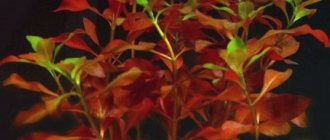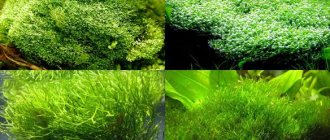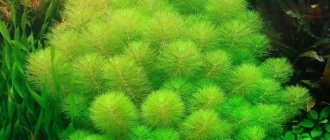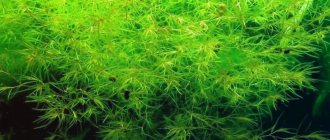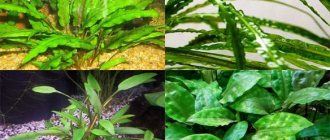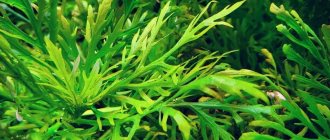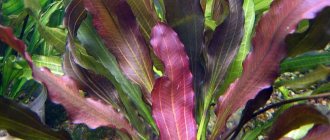The aquarium plant Vallisneria captivates with its unpretentiousness and rapid growth. There are several varieties of this beautiful and unpretentious plant, here are some of them: Vallisneria Nana; Spiral; Gigantic; Tiger; American. Vallisneria can be used as a “living wall” in an aquarium.
In this article we will try to describe in more detail the conditions of detention, reproduction and possible diseases.
Appearance
Vallisneria is native to Northern Australia. This plant belongs to the perennial category. It has a short and poorly developed rhizome, the length of which does not exceed 10 cm. It is characterized by the presence of narrow, long and smooth leaves, reminiscent of variegated ribbons in their appearance.
The plant has a long growth phase, and therefore is ideal for decorating almost any aquarium.
It is recommended to plant the plant near the back walls. The leaf blades are distinguished by a rich emerald green color, but in some cases they can change their color to reddish or brown shades.
Despite the fact that Vallisneria belongs to the category of flowering plants, its inflorescences do not have decorative value, since they are small and not very attractive. The plant reproduces mainly by vegetative means, as well as with the help of lateral shoots.
There are a number of varieties of Vallisneria, each of which has its own special features regarding both appearance and conditions of detention.
Gigantic
A large plant whose leaf height can exceed 2 m. The plant has a rich green color and creates natural shading. This variety of Vallisneria is suitable for large aquariums, and it is recommended to plant it in the corners near the rear walls of the vessel.
The plant adapts well to different types of soil and changes in temperature conditions. But for full growth and development, it needs bright lighting for at least 12 hours a day. The best habitat for giant vallisneria is soft, slightly acidified water.
American
A very beautiful and spectacular plant with soft ribbon-like leaf plates. It can reach a height of 90-100 cm. The leaves have a double color, which is a combination of green and reddish shades. The American twisted-leaved Vallisneria is especially impressive for aquarium decoration, the leaves of which form a beautiful twisted spiral.
To create optimal conditions, the plant requires additional side lighting. Its small size allows this variety of Vallisneria to be used to decorate both the foreground and background of an aquarium.
Spiral
This subspecies is especially loved by aquarists for the ability of the peduncle to curl into a spiral, which looks very beautiful in an aquatic environment. The size of spiral vallisneria is relatively small - no more than 80 cm. The plant needs bright natural light. The optimal daylight hours are approximately 15 hours a day.
In winter, additional lighting is required, because otherwise the leaf blades of spiral Vallisneria lose their beauty, turn pale, thin out, and acquire an unhealthy yellowish color.
Nana
This variety of Vallisneria differs from others in its particularly thin leaf plates of a dark green color, reminiscent of hairs in appearance. A characteristic feature of Vallisneria nana is also its compactness, because the height of the foliage does not exceed 35 cm.
Thanks to this feature, the plant can be used to decorate even small aquariums and planted in the foreground. The optimal environment for growing this variety is clay soil. The plant also needs additional moderate lighting.
Tiger
This crop has a characteristic variegated coloring, which has a clear resemblance to a tiger skin, in honor of which the plant deserves its name. This variety is compact, small in size, and unpretentious in terms of care, which is why tiger vallisneria has gained immense popularity among aquarists. Most often, the plant is planted on the sides of the container in order to create a spectacular background for decorative fish.
Neotropicalis
A beautiful aquarium plant with straight leaves. The leaves of Vallisneria neotropicalis can have different colors, which, depending on the conditions of detention, vary from green to brown and red shades. A large subspecies that is suitable for growing and decorating only in large aquariums.
Nathans
One of the most popular varieties of American Vallisneria. This plant is characterized by thin and narrow leaf blades of a bright green color, the length of which can reach 100 cm.
Aquarists prefer to plant Nathans near the back and side walls for decorative purposes. This culture is valued by users for its increased ability to saturate water with oxygen and normalize metabolic processes.
Description
The genus Vallisneria is represented by perennial aquatic herbs. The habitat of its representatives covers almost all continents and includes temperate zones, subtropics and tropics. Plants can be found both in rivers and streams with a current, and in ponds and lakes with standing water.
The description of appearance is similar for all representatives of the genus. These are bushes with oblong leaves 20-200 cm long. The leaf plates are elastic, dense, green or reddish in color, form a rosette at the base of the bush; some species have sharp serrations along the edges. Plants are characterized by a high growth rate, due to which their leaves quickly reach the surface of the water and begin to spread along it. If there is good lighting, small flowers appear, rising above the surface of the water. The root system is represented by strong, elastic, pale yellow roots up to 10 cm long, with the help of which the plant is anchored in the soil.
Reproduction methods
Vallisneria reproduces both by seed and vegetative methods. In the first option, it is necessary to have female and male subspecies in the aquarium, then pollination occurs and the seeds mature, which begin to germinate over time.
However, most aquarists prefer the more convenient and comfortable vegetative method of propagating Vallisneria. For these purposes, plant shoots are used that germinate upon contact with the ground.
After the sprout has rooted and several leaf blades have formed on it, it can be carefully cut off and replanted. Under favorable climatic conditions and proper maintenance, Vallisneria reproduces and grows very quickly, throughout the whole year.
Spiral
One of the most popular and beautiful species. Visually similar to Vallisneria vulgaris. But its peculiarity is that all the leaves curl into a spiral, which is why the bush looks especially attractive. This is the first Vallisneria discovered by man. Twisting is typical for female bushes. In nature, the plant reaches 80 cm in length, the leaf width is no more than 1.2 cm. Reproduction occurs vegetatively or through seeds. Flowers ripen, emerge, and then pollination occurs through direct contact;
Planting rules
Experts recommend planting Vallisneria near the back and side walls of aquariums in small groups. It is best to place the plant near the filter, namely where the water drains, because then, thanks to the natural flow, the leaves of Vallisneria will be beautifully and evenly distributed over the entire surface of the aquarium.
Since the plant belongs to the category of floating, its position can be fixed using decorative pebbles, shells, driftwood, and large leaves of other underwater crops.
Is it difficult to maintain?
Keeping Vallisneria in an aquarium is quite simple. She is quite satisfied with the conditions created for tropical fish: warm water, comfortable lighting and a certain water hardness .
Most beginners who turn to aquarium farming for the first time choose this plant for their home pond.
Conditions in the aquarium
If the soil is primarily important for domestic plants, then for aquatic species it is the water parameters. First of all , the water poured into the aquarium must be cleared of salts and impurities that negatively affect the plant.
Most species prefer medium hardness (from 5 to 8 pH). Temperature conditions can vary between 23...32 °C. At 15...18 °C it withers.
In moderate lighting, daylight hours should last at least 8 hours . In winter, its duration is maintained using fluorescent lamps.
View this post on Instagram
Publication from guppi.ru (@guppi.ru) July 27, 2021 at 5:26 PDT
How to plant in an aquarium? Vallisneria bushes are planted in an even row, closer to the filter and the rear walls of the aquarium (can be placed along the side walls).
The water fluctuations caused by the filter straighten the leaves so that they grow properly and look beautiful in an artificial pond.
Attention! When planting, the roots need to be deepened into the soil so that the light part of the rosette remains above it. If you close it, the plant will begin to rot.
How is it useful for an aquarium?
As befits a flora, Vallisneria supplies the aquarium with oxygen . In addition, it is able to neutralize phosphates, nitrates and nitrogenous compounds harmful to fish.
Attention! Rust and copper that get into the aquarium with medicines for fish and during water changes can destroy it.
Do I need to fertilize?
The need for feeding arises if the plant does not have enough nutrients extracted from the soil. If it is of high quality, there is a slight silt, then Vallisneria will grow without problems.
View this post on Instagram
Posted by Arovana (@arovana.aqua) Sep 1, 2021 at 4:05 PDT
A lack of nutritional components is indicated by stopped growth and rotting of leaves . In this case, it is necessary to feed with root fertilizers containing iron and calcium.
Content Features
Vallisneria is an absolutely undemanding plant that is suitable even for beginner aquarists. It is resistant to temperature changes, but at very low temperature conditions its growth processes slow down significantly. Vallisneria reacts negatively to very high levels of water hardness, while its leaf blades become smaller and pale, and growth stops.
The plant itself performs a filtering function, and therefore can remain in old water for quite a long time. But to ensure the health and attractive appearance of Vallisneria, it is recommended to periodically change the water in the aquarium, as well as purchase and install a special filter.
This crop can easily do without fertilizing and mineral fertilizers. But for normal growth and full development, it requires nutritious, soft, sufficiently silted soil. River sand or fine gravel is well suited for planting Vallisneria.
With insufficient lighting, the plant begins to stretch, and its leaf blades acquire an unhealthy yellow tint, fade and lose their beauty. To avoid such problems, aquarists are recommended to use additional lighting in the form of LEDs and fluorescent lamps. Vallisneria responds especially well to natural sunlight.
This plant has the property of rapid growth and shading of the water surface.
In cases where the thickets of Vallisneria become too dense and create a lack of light for other crops and aquarium inhabitants, it is necessary to thin out the plant, removing it along with the rhizome.
Experts do not recommend trimming the tops of Vallisneria, since after such a procedure its leaves turn pale and begin to rot. In addition, the main cause of plant disease is low quality tap water. To grow Vallisneria, it is recommended to use filtered, pre-purified water.
Soil and fertilizing
The composition of the soil does not matter much. An unpretentious aquarium plant, Vallisneria takes root well in any substrate. The ideal size of soil particles is 4-6 mm. The thickness of the soil layer should be about 4 cm. It is recommended to select a nutritious sand or gravel substrate.
The grass is fertilized from time to time. Specialized stores sell ready-made complex fertilizers in tablets or plates. No clay or peat is added to the soil; it is enough to feed in tablets.
Popular tips from professionals
For better growth and development of Vallisneria, aquarists are advised to take note of the following tips regarding caring for it:
- To avoid the development of putrefactive processes affecting the leaf blades of Vallisneria, it is recommended to fertilize the plant from time to time, using specialized fertilizers for this purpose in tablet form or in the form of a paste.
- This culture does not require additional oxygen or carbon dioxide.
- It is recommended to update the water in the aquarium by 20-25%, at least once a week.
- The optimal water hardness is 8°.
- The recommended acidity of the aquatic environment should not exceed 7 units.
- This plant should be cared for carefully, as its leaves are quite hard, sharp and can injure the skin.
- It is important to ensure that impurities of copper, salt, iron and rust, which are detrimental to Vallisneria, do not get into the water.
- The plant gets along well with other crops and most aquarium inhabitants. The only exceptions are burrowing, bottom-dwelling fish that can damage its root system.
If you follow these simple recommendations, Vallisneria will actively grow, multiply and delight the eye with its bright colors.
Compatibility
Beginners and experienced aquarists combine American and tiger species with algae and shady vegetation. They are planted in tanks containing shellfish, aggressive and peaceful fish phenotypes, shrimp, and cryptocoryne.
But before landing, the optimal location is determined. So, these bushes and cryptocoryne are concentrated near filtration equipment and aerators. After all, this vegetation needs clean water and constant oxygen supply.
Vallisneria is an amazing plant. With its help, conditions are created in the aquarium and other tanks that are necessary for the normal development and reproduction of phenotypes and mollusks. If you control its growth, then other algae and shady plants will develop normally.
Video about the aquarium plant Vallisneria
AdminAuthor of the article
Did you like the article?
Share with your friends:
Beneficial features
Vallisneria forms amazingly beautiful cascades of leaf blades of rich emerald green color. But, in addition to the decorative function, the plant also performs other important tasks.
Vallisneria perfectly filters the water in the aquarium, effectively purifying it from impurities and harmful impurities, and saturates the container with actively released oxygen. This plant also creates shading and prevents the growth of algae and weeds.
Vallisneria is a very beautiful and unusual aquarium plant that allows you to create an original design that performs a number of additional useful functions. This aquatic culture is especially loved by aquarists due to its unpretentiousness and lack of need for careful, complex care.
But in order to ensure full development of Vallisneria, prolong its life, and also protect it from a number of characteristic diseases, it needs to create optimal conditions, which require sufficient lighting, average hardness and acidity, and periodic replacement of water in the aquarium.
Basic care
Vallisneria is undemanding to both soil and growing conditions. Important steps are timely change of water and additional lighting. The water should not contain foreign additives, medications or other components, and the temperature and hardness should be normal.
When cleaning the tank, you must be very careful not to damage the skin on the sharp edges of the leaves. Otherwise, you can care for Vallisneria in exactly the same way as other aquarium vegetation.
By following the rules and hygiene of the aquarium, you can grow a healthy and beautiful ornamental plant that benefits many species of fish and shellfish.

